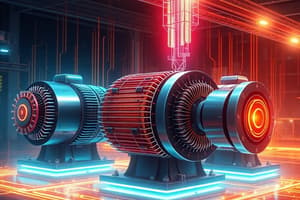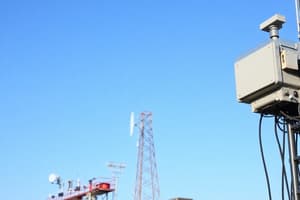Podcast
Questions and Answers
What is the primary function of pulse width modulation in the converter operation?
What is the primary function of pulse width modulation in the converter operation?
- To ensure the input current is in phase with the source voltage (correct)
- To convert AC voltage to DC voltage
- To increase the input voltage to the converter
- To minimize harmonic content in the output signal
Which component of the diagnostic system functions like an expert system?
Which component of the diagnostic system functions like an expert system?
- Firmware that processes and stores messages (correct)
- Hardware that analyzes all data
- The microprocessor controlling locomotive functions
- Application software defining working rules
What is classified as Level I faults in the diagnostic system?
What is classified as Level I faults in the diagnostic system?
- Faults that only require audio-visual indication (correct)
- Faults related to bogie operation only
- Critical faults requiring immediate isolation
- Faults that necessitate manual intervention
How does the converter achieve a unity power factor?
How does the converter achieve a unity power factor?
What is the role of application software in the diagnostic system?
What is the role of application software in the diagnostic system?
What microprocessor functions are critical in modern rail vehicles using three phase technology?
What microprocessor functions are critical in modern rail vehicles using three phase technology?
What is one of the main disadvantages of traditional DC traction motors?
What is one of the main disadvantages of traditional DC traction motors?
What critical issue does the use of thyristor DC traction motor drives suffer from?
What critical issue does the use of thyristor DC traction motor drives suffer from?
Which feature of three phase induction motors makes them more advantageous than DC series motors?
Which feature of three phase induction motors makes them more advantageous than DC series motors?
What is a benefit of electric braking in three phase technology?
What is a benefit of electric braking in three phase technology?
Why is there an increasing emphasis on regeneration in traction applications?
Why is there an increasing emphasis on regeneration in traction applications?
What is one of the primary reasons for moving from DC motors to three phase technology in locomotives?
What is one of the primary reasons for moving from DC motors to three phase technology in locomotives?
What happens to the breakdown torque when frequency is increased above the base speed with constant voltage?
What happens to the breakdown torque when frequency is increased above the base speed with constant voltage?
Which inverter technology was predominantly used in the past for induction motor drives due to the availability of conventional thyristors?
Which inverter technology was predominantly used in the past for induction motor drives due to the availability of conventional thyristors?
What is the primary purpose of the front-end converter in the power conversion process?
What is the primary purpose of the front-end converter in the power conversion process?
Which of the following electric braking types can be utilized in the input converter circuitry?
Which of the following electric braking types can be utilized in the input converter circuitry?
What is a significant feature of traction applications concerning torque requirements?
What is a significant feature of traction applications concerning torque requirements?
What must be maintained constant to keep the breakdown torque constant?
What must be maintained constant to keep the breakdown torque constant?
Which components are necessary for the power schematic of a three-phase AC locomotive?
Which components are necessary for the power schematic of a three-phase AC locomotive?
What does the electricity utility's limits on reactive power harmonics influence?
What does the electricity utility's limits on reactive power harmonics influence?
What is the boost factor achieved by the front-end converter during DC conversion?
What is the boost factor achieved by the front-end converter during DC conversion?
What type of inverter requires complicated control electronics to be effective?
What type of inverter requires complicated control electronics to be effective?
What is the energy efficiency comparison of induction motor drives to DC drives?
What is the energy efficiency comparison of induction motor drives to DC drives?
What advantage do three phase drives provide in terms of power factor?
What advantage do three phase drives provide in terms of power factor?
What improvement does electric braking provide when using three phase drives?
What improvement does electric braking provide when using three phase drives?
What technological advancement made it possible to supply a three phase motor with VVVF sources?
What technological advancement made it possible to supply a three phase motor with VVVF sources?
What characterizes the torque developed in a squirrel cage induction motor?
What characterizes the torque developed in a squirrel cage induction motor?
What happens to the rotor power factor when the supply frequency is reduced in an adjustable frequency drive?
What happens to the rotor power factor when the supply frequency is reduced in an adjustable frequency drive?
Why is low frequency crawling a concern when starting induction motors?
Why is low frequency crawling a concern when starting induction motors?
What characteristic is shown in the torque-speed graph for a constant v/f drive?
What characteristic is shown in the torque-speed graph for a constant v/f drive?
What is a consequence of the starting current being 5 to 6 times the rated current in a cage rotor induction motor?
What is a consequence of the starting current being 5 to 6 times the rated current in a cage rotor induction motor?
What advantage does microprocessor control provide in traction rolling stock?
What advantage does microprocessor control provide in traction rolling stock?
What is the primary function of the DC link in traction rolling stock?
What is the primary function of the DC link in traction rolling stock?
Which component is responsible for converting AC to DC in the traction system?
Which component is responsible for converting AC to DC in the traction system?
Which of the following is NOT a feature of microprocessor control?
Which of the following is NOT a feature of microprocessor control?
What does a voltage source inverter supply in traction rolling stock?
What does a voltage source inverter supply in traction rolling stock?
How does the DC link capacitor function within the system?
How does the DC link capacitor function within the system?
What is the role of the series tuned filter in the DC link?
What is the role of the series tuned filter in the DC link?
What capability does the microprocessor enable for automatic control systems in locomotives?
What capability does the microprocessor enable for automatic control systems in locomotives?
What is the purpose of using a 4-quadrant converter in traction rolling stock?
What is the purpose of using a 4-quadrant converter in traction rolling stock?
What challenge does microprocessor technology address in traction rolling stock?
What challenge does microprocessor technology address in traction rolling stock?
What is one significant advantage of using three phase AC drive technology over traditional DC traction motors?
What is one significant advantage of using three phase AC drive technology over traditional DC traction motors?
Why is the transition from DC motors to three phase technology necessary in modern locomotives?
Why is the transition from DC motors to three phase technology necessary in modern locomotives?
What operational issue is prevalent with traditional DC traction motors due to their design?
What operational issue is prevalent with traditional DC traction motors due to their design?
What major drawback is associated with thyristorised DC traction motor drives despite their improved efficiency?
What major drawback is associated with thyristorised DC traction motor drives despite their improved efficiency?
Which component in three phase technology contributes to the improvement of power factor?
Which component in three phase technology contributes to the improvement of power factor?
What does the increasing emphasis on regeneration in traction applications aim to achieve?
What does the increasing emphasis on regeneration in traction applications aim to achieve?
What primary factors contribute to the robust design of three phase traction motors?
What primary factors contribute to the robust design of three phase traction motors?
What effect does controlling the modulating wave have on the converter's operation?
What effect does controlling the modulating wave have on the converter's operation?
What is the primary role of the firmware in the diagnostic system of locomotives?
What is the primary role of the firmware in the diagnostic system of locomotives?
In the context of locomotive diagnostics, which level is categorized by automatic corrective actions without visual indications?
In the context of locomotive diagnostics, which level is categorized by automatic corrective actions without visual indications?
Which of the following components describes the hardware structure utilized in the locomotive diagnostic system?
Which of the following components describes the hardware structure utilized in the locomotive diagnostic system?
How is the converter's input current characterized in relation to the voltage across the reactor?
How is the converter's input current characterized in relation to the voltage across the reactor?
What is the primary advantage of squirrel cage induction motors over DC commutator motors in terms of operational voltage?
What is the primary advantage of squirrel cage induction motors over DC commutator motors in terms of operational voltage?
How does the power-to-weight ratio of induction motors compare to that of DC motors?
How does the power-to-weight ratio of induction motors compare to that of DC motors?
What benefit does the high adhesion coefficient of induction motors provide during operation?
What benefit does the high adhesion coefficient of induction motors provide during operation?
What technological feature enhances the control capabilities of modern locomotives using three-phase technology?
What technological feature enhances the control capabilities of modern locomotives using three-phase technology?
Which characteristic differentiates the torque-speed curve of induction motors from that of traditional DC machines?
Which characteristic differentiates the torque-speed curve of induction motors from that of traditional DC machines?
What role does the microprocessor play in fault diagnostics within traction systems?
What role does the microprocessor play in fault diagnostics within traction systems?
What is one advantage of using microprocessor control in modern traction rolling stock?
What is one advantage of using microprocessor control in modern traction rolling stock?
What happens to the air gap flux as frequency increases above the rated motor speed while maintaining voltage constant?
What happens to the air gap flux as frequency increases above the rated motor speed while maintaining voltage constant?
How does the reduction in operating current affect the design of power cables in traction systems?
How does the reduction in operating current affect the design of power cables in traction systems?
What aspect of software in microprocessor control enhances its functionality?
What aspect of software in microprocessor control enhances its functionality?
Which type of inverter was predominantly used in the past for induction motor drives prior to the advancements in GTOs?
Which type of inverter was predominantly used in the past for induction motor drives prior to the advancements in GTOs?
Which of the following is NOT a typical electric braking method used in traction systems?
Which of the following is NOT a typical electric braking method used in traction systems?
What is the primary purpose of stepping down AC voltage in the power conversion process?
What is the primary purpose of stepping down AC voltage in the power conversion process?
What is an advantage of using three phase drives over DC drives in terms of energy efficiency?
What is an advantage of using three phase drives over DC drives in terms of energy efficiency?
Which factor does NOT influence the design of the input converter circuitry in a traction system?
Which factor does NOT influence the design of the input converter circuitry in a traction system?
What essential feature does three phase drive technology offer concerning operational efficiency?
What essential feature does three phase drive technology offer concerning operational efficiency?
What is the function of the filter stage in the DC conversion process?
What is the function of the filter stage in the DC conversion process?
What technological advancement facilitated the supply of three phase motors with VVVF sources?
What technological advancement facilitated the supply of three phase motors with VVVF sources?
What distinguishes traction applications in terms of torque requirements?
What distinguishes traction applications in terms of torque requirements?
What does the circuitry of the input converter provide for in a traction power system?
What does the circuitry of the input converter provide for in a traction power system?
Which condition must be met for regeneration to occur in three phase induction motors?
Which condition must be met for regeneration to occur in three phase induction motors?
What is the impact of reducing supply frequency in an adjustable frequency drive?
What is the impact of reducing supply frequency in an adjustable frequency drive?
What characteristic is expected when maintaining a constant v/f ratio in a drive system?
What characteristic is expected when maintaining a constant v/f ratio in a drive system?
What phenomenon occurs with the starting current of a typical cage rotor induction motor?
What phenomenon occurs with the starting current of a typical cage rotor induction motor?
What risk is associated with starting induction motors on a fixed frequency supply?
What risk is associated with starting induction motors on a fixed frequency supply?
How is the torque developed in a squirrel cage induction motor characterized?
How is the torque developed in a squirrel cage induction motor characterized?
What is the significance of the power factor in starting torque for an induction motor?
What is the significance of the power factor in starting torque for an induction motor?
Flashcards
Three-phase AC traction
Three-phase AC traction
Modern rail vehicles use three-phase AC drive technology with GTO thyristors and microprocessor control.
Problems with DC traction motors
Problems with DC traction motors
DC motors have issues with brushes, commutators and a lower power-to-weight ratio compared to three-phase AC motors.
Microprocessor control
Microprocessor control
A microprocessor system controls the vehicle, monitors components, performs diagnostics and selects the best PWM technique for motor performance.
Regeneration
Regeneration
Signup and view all the flashcards
Three-phase induction motor advantages
Three-phase induction motor advantages
Signup and view all the flashcards
Higher load hauling
Higher load hauling
Signup and view all the flashcards
Track friendly locomotives
Track friendly locomotives
Signup and view all the flashcards
Three-phase drive advantages
Three-phase drive advantages
Signup and view all the flashcards
Induction motor energy efficiency
Induction motor energy efficiency
Signup and view all the flashcards
Variable Voltage Variable Frequency (VVVF) drive
Variable Voltage Variable Frequency (VVVF) drive
Signup and view all the flashcards
Starting current of induction motor
Starting current of induction motor
Signup and view all the flashcards
Starting torque of Induction Motor
Starting torque of Induction Motor
Signup and view all the flashcards
Regeneration speed condition
Regeneration speed condition
Signup and view all the flashcards
Adjustable frequency drive
Adjustable frequency drive
Signup and view all the flashcards
Speed/Torque characteristic (constant V/f)
Speed/Torque characteristic (constant V/f)
Signup and view all the flashcards
Breakdown Torque
Breakdown Torque
Signup and view all the flashcards
V/f Constant
V/f Constant
Signup and view all the flashcards
Stator Voltage Limit
Stator Voltage Limit
Signup and view all the flashcards
Air Gap Flux
Air Gap Flux
Signup and view all the flashcards
Traction Applications
Traction Applications
Signup and view all the flashcards
Motor Voltage/Current Variation
Motor Voltage/Current Variation
Signup and view all the flashcards
Current Source Inverter
Current Source Inverter
Signup and view all the flashcards
Voltage Source Inverter
Voltage Source Inverter
Signup and view all the flashcards
Boost Factor
Boost Factor
Signup and view all the flashcards
Main Transformer
Main Transformer
Signup and view all the flashcards
Microprocessor Benefits
Microprocessor Benefits
Signup and view all the flashcards
Locomotive Control Functions
Locomotive Control Functions
Signup and view all the flashcards
Voltage Source Inverter (VS Inverter)
Voltage Source Inverter (VS Inverter)
Signup and view all the flashcards
DC Link
DC Link
Signup and view all the flashcards
DC Link Components
DC Link Components
Signup and view all the flashcards
Input Side Converter
Input Side Converter
Signup and view all the flashcards
Energy Efficiency
Energy Efficiency
Signup and view all the flashcards
Three-Phase ABB Locomotive Modules
Three-Phase ABB Locomotive Modules
Signup and view all the flashcards
Harmonics Absorption
Harmonics Absorption
Signup and view all the flashcards
Converter Input Current
Converter Input Current
Signup and view all the flashcards
Unity Power Factor
Unity Power Factor
Signup and view all the flashcards
Modulating Wave
Modulating Wave
Signup and view all the flashcards
Diagnostic System Levels
Diagnostic System Levels
Signup and view all the flashcards
Level I Faults
Level I Faults
Signup and view all the flashcards
Why Three Phase Traction?
Why Three Phase Traction?
Signup and view all the flashcards
What's the Need for Change?
What's the Need for Change?
Signup and view all the flashcards
What is Regeneration?
What is Regeneration?
Signup and view all the flashcards
What is Variable Voltage Variable Frequency (VVVF) Drive?
What is Variable Voltage Variable Frequency (VVVF) Drive?
Signup and view all the flashcards
What are the benefits of Microprocessor Control?
What are the benefits of Microprocessor Control?
Signup and view all the flashcards
What are the Key Components of a Three-Phase Traction System?
What are the Key Components of a Three-Phase Traction System?
Signup and view all the flashcards
Why AC Traction?
Why AC Traction?
Signup and view all the flashcards
Induction Motor Torque
Induction Motor Torque
Signup and view all the flashcards
Regeneration in Traction
Regeneration in Traction
Signup and view all the flashcards
Benefits of Microprocessor Control
Benefits of Microprocessor Control
Signup and view all the flashcards
Three-Phase Traction System
Three-Phase Traction System
Signup and view all the flashcards
Input Converter
Input Converter
Signup and view all the flashcards
VS Inverter
VS Inverter
Signup and view all the flashcards
Current Source Inverter (CSI)
Current Source Inverter (CSI)
Signup and view all the flashcards
Voltage Source Inverter (VSI)
Voltage Source Inverter (VSI)
Signup and view all the flashcards
Three-phase drive efficiency
Three-phase drive efficiency
Signup and view all the flashcards
Three-phase drive regeneration
Three-phase drive regeneration
Signup and view all the flashcards
Three-phase drive power factor
Three-phase drive power factor
Signup and view all the flashcards
Induction motor speed/torque
Induction motor speed/torque
Signup and view all the flashcards
Induction motor starting
Induction motor starting
Signup and view all the flashcards
Variable frequency drive (VFD)
Variable frequency drive (VFD)
Signup and view all the flashcards
VVVF Drive
VVVF Drive
Signup and view all the flashcards
Microprocessor control benefits
Microprocessor control benefits
Signup and view all the flashcards
Diagnostic Levels
Diagnostic Levels
Signup and view all the flashcards
Study Notes
Three Phase Technology for Traction Application
- Three-phase AC drive technology is common in modern rail vehicles.
- These vehicles use GTO thyristors and microprocessor control systems for vehicle control, monitoring health, and diagnostics.
- The technology offers improvements in terms of technical and economic aspects.
Need for Change
- Earlier locomotives used DC traction motors.
- Speed/torque regulation was achieved through tap changers on transformers or resistance control.
- Conventional relay-based protection schemes were used.
- Driver discretion was often used for diagnostics and troubleshooting.
- DC motors have limitations, including brush gear, commutator problems, low power-to-weight ratio, and costly large cables and reverser systems.
- Thyristorised DC motor drives, while more efficient, had issues with harmonic injection.
- Regeneration is increasingly prioritized to reduce energy costs.
Advantages of Three-Phase Technology
- Three-phase induction motors are robust and require less maintenance.
- They have fewer wear-prone parts and are less sensitive to dust and vibration.
- They can operate at higher speeds (4000 rpm) compared to DC motors (2500 rpm).
- Induction motors provide higher power-to-weight ratios than DC motors.
- Induction motor power characteristics allow for more efficient use of maximum adhesion.
- Reduced track maintenance is achieved by the use of three-phase induction motors with improved efficiency.
- There is higher energy efficiency compared to DC motors.
- Regeneration and unity power factor operation are possible with three-phase drives.
Variable Voltage Variable Frequency Drives
- Adjustable frequency drives allow induction motors to function properly at the start.
- Lower starting frequency improves power factor and increases torque/ampere at start.
- Rapid acceleration to operating speed is possible through increased frequency.
Microprocessor Control
- Microprocessor control systems are used in three-phase ABB locomotives.
- Hardware is significantly optimized with smaller size, lighter weight, and less power consumption.
- Software is efficient and used to execute complex control algorithms and diagnostics.
- Reduced space, weight, and power consumption is achieved;
- Self-diagnostic functions for failure detection are possible.
- Microprocessor control facilitates automatic speed regulation and supervision of functionalities.
Instrumentation, Braking, and Pneumatic System
- Sophisticated data acquisition systems are used for monitoring.
- Regenerative braking is efficient in reducing wear on break shoes.
- New modular pneumatic panels from Devis and Matcalfe are used with improved reliability.
- Flexi-float bogies with dual-stage suspension enhance track-friendliness and reduce stress on track.
Overall Conclusion
- Three-phase technology benefits for Traction Application with higher efficiency and lesser maintenance are possible with advancements in three-phase systems.
Studying That Suits You
Use AI to generate personalized quizzes and flashcards to suit your learning preferences.




